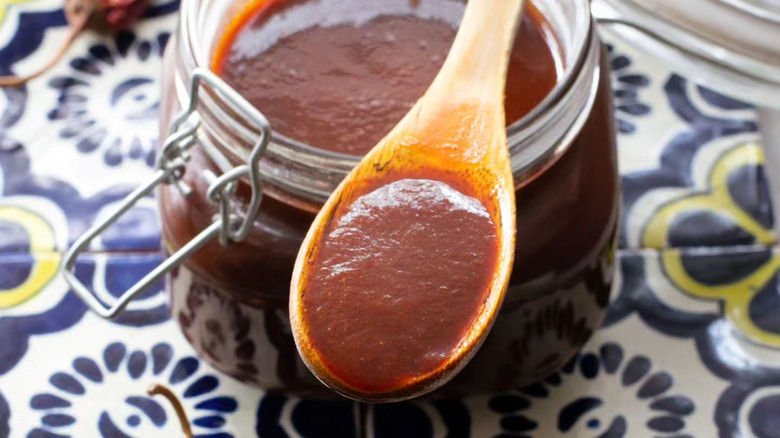What Is Guajillo Sauce And What Does It Taste Like?
Chile sauces come in so many varieties that you might wonder what their differences are beyond being considered "red" or "green." Knowing that red sauces are made with tomatoes and dried chiles, whereas green sauces rely on tomatillos and fresh chiles, is a start. But some chile sauces are named after the specific type of pepper they're made from. This is the case with salsa de chile guajillo — also known as guajillo sauce.
Guajillo chiles are ubiquitous throughout Mexico. The dark chiles give the deep red guajillo sauce its signature flavor, inviting aroma, and much of its enticing color. Guajillo chiles — also known as mirasol peppers before they are dried — are robust and smoky with a moderate amount of heat. Straight from the bag, they smell a bit like raisins but the fruity, berry-like taste they effuse is much milder than that of dried grapes. Combined with other ingredients, guajillo peppers produce a rich sauce that's used as a condiment on a variety of Mexican dishes, including tacos, quesadillas, chilaquiles, tortas, and gorditas, and as a dip for plain tortilla chips. It's often used inside of tamales as well.
What's in guajillo sauce besides guajillo chiles?
Although dried guajillo chiles form the base of guajillo sauce, they aren't used as is. When you make a guajillo sauce, many recipes call for the chiles to be briefly toasted on a comal or skillet first. Then, since they are dried peppers, they have to be rehydrated. This is done either by simmering them on the stove for 10 minutes or soaking the chiles in a bowl of hot water for up to half an hour. The guajillos can be deseeded if desired, either before toasting them or after rehydrating them. Deseeding will result in a less spicy sauce since most of the heat is in the seeds. The stems should come off at some point before the chiles are combined with other ingredients; they're woody and tough.
Guajillo sauce has onions, garlic, spices, and (sometimes) tomatoes. The tomatoes need to be cooked, so it makes sense to simmer them with the peppers if you rehydrate the peppers on your stovetop. The cooking water typically is reserved to thin the sauce once all of the ingredients are pureed. And of course, salt is added to taste. The pureed sauce will then need to be simmered on the stove with a small amount of vegetable or olive oil for roughly 15 minutes.
What does guajillo sauce taste like?
Like the peppers that it is named after, guajillo sauce is rich and smoky, with hints of fruitiness. It is slightly sweet and pungent, with notes of earthiness. It can also be a little bitter, especially if the peppers are toasted too long or too much of the soaking water is used to thin the sauce. When tomatoes are included, the sauce will have a more acidic tang, which can cut through some of the earthy smokiness and make those flavors less prominent. Onions give this sauce a dose of savoriness, while garlic gives guajillo sauce a little kick. Onions and garlic can enliven the guajillo sauce, which is not very spicy, as the chile peppers it is made from are rather mild.
You might recognize many of the flavors in guajillo sauce from other Mexican dishes that utilize this popular pepper, such as moles, menudo, pozole, and birria. Its unique blend of flavors and not-too-spicy palate make it perfect for slow-cooking meats, such as in a recipe for pork stewed in guajillo chile mole. It's also commonly used to season meats and as a base for enchilada sauce.


